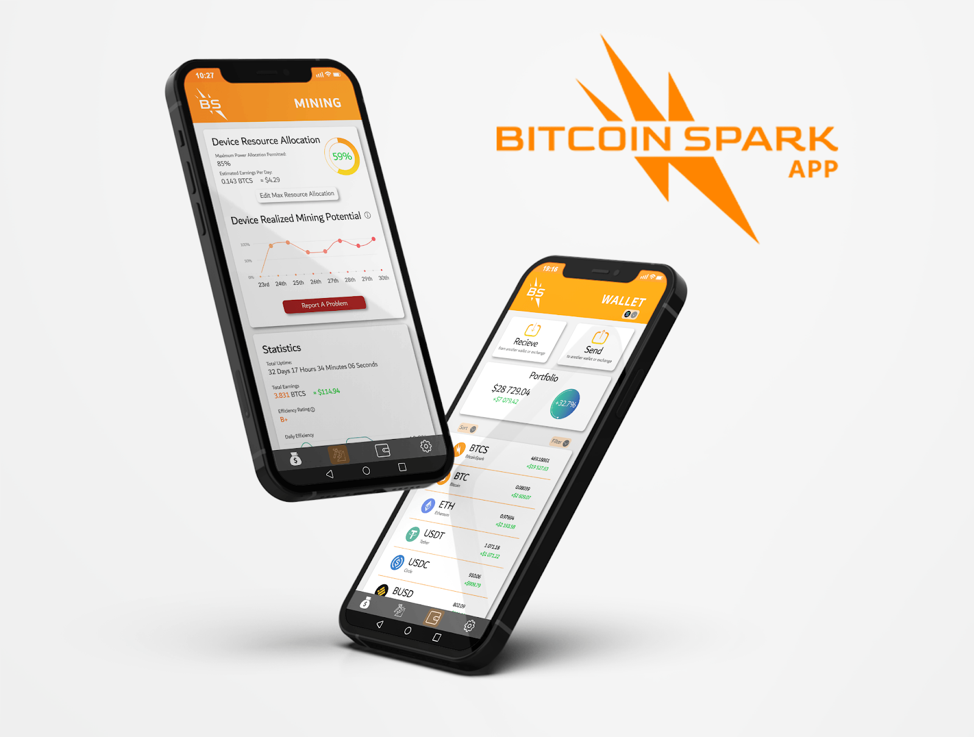
Excitement is rife in Ethereum and Monero camp as they gear up for an extraordinary endeavor: mining the newest Bitcoin variant. As new cryptocurrencies emerge, they present unique opportunities and challenges for miners seeking to participate in this dynamic landscape. Let’s explore details as miners prepare to mine an improvement on Bitcoin, Bitcoin Spark.
Bitcoin Spark (BTCS)
Bitcoin Spark is a new project striving to address Bitcoin’s transaction costs and remove barriers to the mining process. How will it address this problem? Bitcoin Spark uses an all-new blockchain technology called “Proof-Of-Process” (PoP), comprising proof of stake and proof of work. The Bitcoin Spark solution comprises smart contracts, transaction speeds, and making mining available to all through computational power rentals.
The Bitcoin Spark Application seeks to achieve two main goals: distributing mining rewards fairly regardless of computational power and utilizing ‘proof-of-work’ to rent out mining device processing power to companies and individuals. The network employs a proprietary proof-of-work/proof-of-stake concept that rents out processing power for various purposes. The team plans to develop an easy-to-use mining program for different platforms, ensuring secure and isolated access to device processing units. This approach enhances security and decentralization, making it difficult for any single entity to control the network.

By avoiding linear reward increases with computational power, Bitcoin Spark minimizes the risk of any single miner becoming too powerful and compromising network security. The blockchain’s transaction finality is distributed across multiple devices and miners, significantly enhancing security. Bitcoin Spark’s revenue-based system ensures that mining rewards remain sustainable and reduced as revenue inflows increase, making the network self-sustaining and profitable for participants. Through these mechanisms, Bitcoin Spark seeks to achieve true decentralization and foster a stable and thriving network.
Imagine being able to buy Bitcoin when it was only 1$. You get this chance by participating in its ICO. Bitcoin Spark allows you to onboard the Bitcoin family at an affordable cost of $1.50 in its ICO phase one starting August 1. Remember, the early adopters stand to make 800% when the project launches at $10.
How to mine Ethereum?
Ethereum is the largest altcoin and comes second to Bitcoin in market capitalization. Mining Ethereum involves validating transactions and adding them to the blockchain through computational efforts. To start mining Ethereum, you’ll need a few essential steps. Firstly, set up an Ethereum wallet to store your mined coins. Then, choose between GPU or ASIC mining hardware, with GPU mining being more accessible for beginners. Next, download and install mining software and configure it to connect to the Ethereum network. Join a mining pool to combine resources with other miners and increase the chances of earning rewards. Once everything is set up, launch the mining software and let it run, using your hardware’s processing power to solve complex mathematical problems and validate transactions. Remember that mining can be energy-intensive, so consider the associated costs and potential profits before getting started.
How to mine Monero?
Monero (XMR) is a decentralized and privacy-focused cryptocurrency based on open-source blockchain technology similar to Bitcoin but with a key emphasis on transaction privacy and anonymity. Monero’s primary goal is to provide users with enhanced privacy and fungibility, making it challenging to trace transactions and link them to specific individuals or addresses.
Monero mining is the process of validating transactions and creating new blocks on the Monero network. Miners use high-powered software and hardware to solve cryptographic equations through the RandomX algorithm, which differs from Bitcoin’s SHA-256 algorithm. Monero mining can be done using a computer’s CPU/GPU, making it accessible to anyone with a computer. Miners are rewarded with newly mined XMR coins for validating blocks of transactions. Monero mining requires computational power and may increase energy consumption, so consider the associated costs and rewards before starting. You will need a wallet and mining software. You will join a pool or mine solo. The mining software uses your CPU or GPU resources, and you will receive rewards proportional to your contribution.
Find more information on Bitcoin Spark here:
Website: https://bitcoinspark.org/
Buy BTCS: https://network.bitcoinspark.org/register
Disclaimer: The statements, views and opinions expressed in this press release are solely those of the content provider and do not necessarily represent those of CoinChapter. CoinChapter will not be responsible in any way for the content of the same. Do your research and invest at your own risk.

